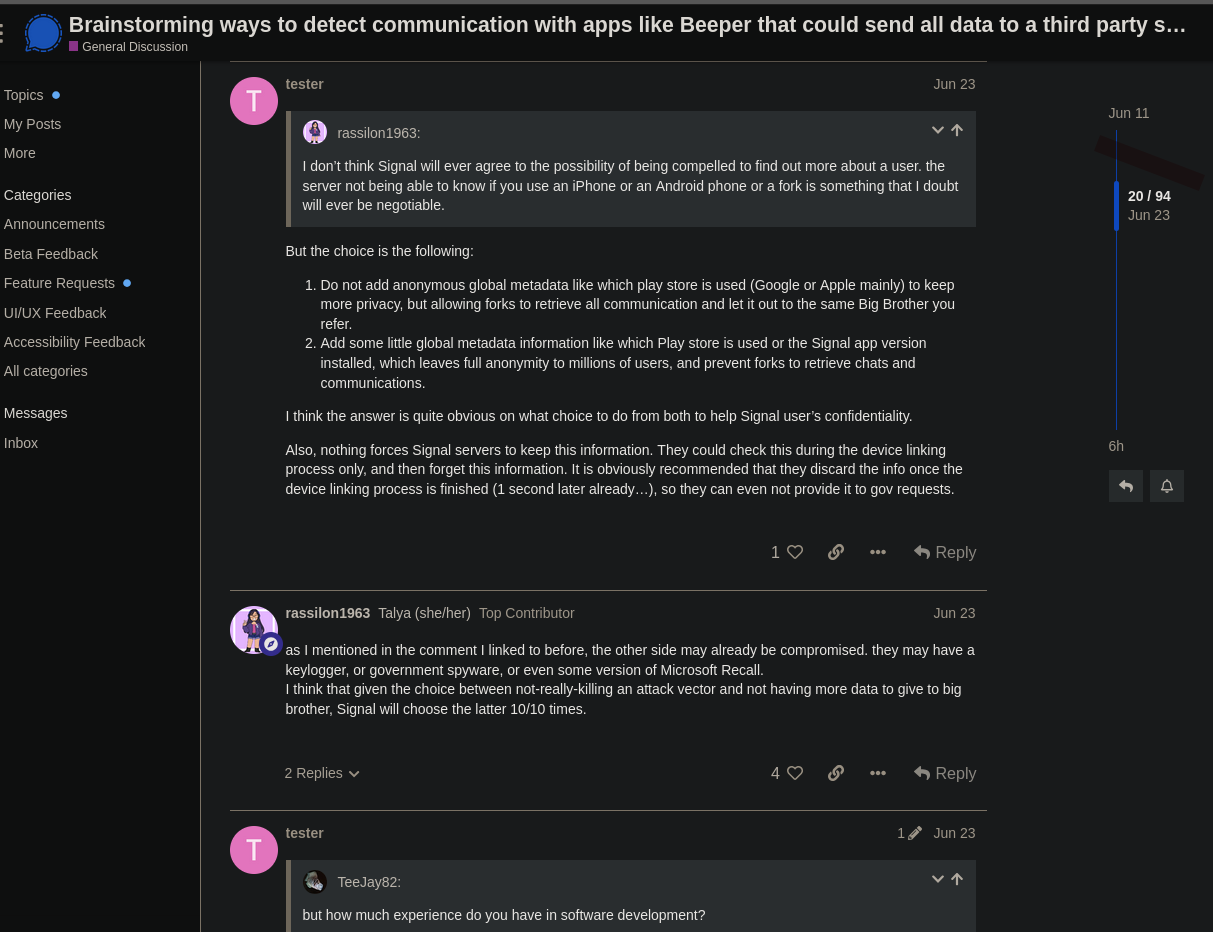For me it’s: Testdisk (and Photorec) Caddy Netstat Dig Aria2
Dwarf Fortress no longer counts, huh?
I see you are one of our elders.
INOTIFY a GUI for monitor file changes. https://en.wikipedia.org/wiki/Inotify
Hmm, I might try to make that. Any particular feature you are looking for, or is just displaying all the events in a table good 'nuff?
I’m not them, but sorting by columns, filtering, searching with highlights would be useful. Also, specifying the columns you wish to see.
After writing it down this sounds just plain spreadsheet operations, so the real value of such a tool would be to do all the above at the same time as watching changes.
There’s also other things that would be useful. Like a feature to select multiple directories for watching. Live output to file in original format. Maybe also JSON for when you would use it from code, but that’s maybe not that useful because then why not just use the API directly… Perhaps some patterns for which ones to send as an audible system notification.
A single, decent, maintained one for LVM.
Redhat had a couple of goes at this and they suck ass big time and rely on KDE (so no good for any other DE / WM). I’m not sure anything really works, so I’ll say: none exist.
Rclone. Not because it’s a complicated tool, but because I would like a history of my file transfers and a few graphs to show we what speeds, files sizes and whether the transfer succeeded. At the moment in order to confirm my home backups have succeeded, I have to run a separate size comparisons between my different datastores.
I feel like you can parse a --dry-run
Thanks. I think I looked at doing that when setting it up, and it was more expensive in terms of API calls. With a cloud vendor you have to be careful of that, so I opted for the SIZE command.
Probably not what you want, but rclone now has a simple web ui built in: https://rclone.org/gui/
I looked at it a few months back and it didn’t have the history side of things, just the setup and realtime stats which I’d already got through the CLI. Thanks tho!
Mount a network share permanently on Kubuntu. Non IT people need to do backups too. And Plasma apps can’t access network shares unless they are mounted.
I think https://apps.kde.org/smb4k/ can do this?
Thanks. I’ve tried it. But it’s not a permanent mount. The program needs to be running all the time. And it frequently times out. A very poor experience. Other OSs do much better.
Have you considered a network file sharing system other than SMB?
I’ve kinda grown towards CLI the last year or so. I used to make wrappers around CLIs for myself even haha
I’d like a GUI app for generating CLI’s for other GUI apps that don’t have them already. An application is never complete unless everything can be done via a CLI and/or API.
This is an interesting idea. There are some tools out there to auto-generate shell autocompletes based on standardized
--helpoutput. Maybe there’s some possibility to GUIfy that sort of thing?I’m not sure how that could even be done, maybe a way to control the GUI with commands that you’d then be able to script, like Selenium on browsers?
w3m, as weird as that sounds, for image drawing.linksgraphical mode is nice, but I’m not a fan of its keybindings, and w3mimagedisplay is hacky at best, to say the least.I’d love supported GUI apps for pacman and systemd. I know there are GUI’s out there for them, but they are not supported by the main project, so they don’t count.
Systemd’s problems won’t be solved with a GUI. Now that lennart’s gone to Microsoft we can hope they upgrade in rhel10 or 11 to upstart or sysv.
Yeah I think a good GUI for systemd will be super useful even for people comfortable with command line.
Sometimes you need an overview of what is running on the system.
There’s a TUI called sysz for systemd stuff, but I haven’t found a true GUI
TIL! thanks!
Why don’t they count? The systemd interface has been stable for a decade.
They don’t count for me, because I can’t get support from the main project if it has a bug.
You can’t get support from lemmy.linuxuserspace.show or any other website if there’s a bug in your web browser. You can’t get support from gmail or protonmail or any other mail provider if there’s a bug in your email client. It’s awful how much people have come to assume that clients and servers must and always come from the same provider.
systemctl
- gnome/gtk: https://github.com/GuillaumeGomez/systemd-manager
- kde/qt: https://invent.kde.org/system/systemdgenie
- browser based: https://cockpit-project.org/
- curses: https://github.com/ana-cc/chkservice
Love the Systemd-Manager 🥰
Ffmpeg.
Came here for this one
Try WinFF
There’s no CLI that k wish I had a GUI for, but there’s many GUIs for which I wish there was a CLI version.
The cli controls the computer while the GUI controls the user
Why would i use something so restrictive as cli tools when i can change the data directly with assembly?
I issue electricity directly to the pins.
So crude, when you could use a butterfly.
Not at all.They are 2 ways do the same thing. The GUI can tell you what options are available. The CLI needs you to memorise them, or go somewhere else to look them up.
A lot of GUIs have less options available than their CLI equivalents. Moreover GUIs change more often, requiring you to relearn the actions to get the expected result Shells can remember the commands you used, commands are also way easier to write down on paper than a list of actions to do on a GUI And using man or --help is not going somewhere to know the options, you stay in the shell If you want to know all the features of a tool, reading the manual is also easier than browsing all the GUI
The CLI lets the user automate tasks, giving them more control over their workflow
Git - the Github Desktop application is a great example of how easy git could be for users like me who only rarely use git. Every time I need to do somethign other then a simple pull or push I need to look it up and by the time I need it again I have forgotten the command and need to look it up again. Just give me something like Github Desktop on linux
Lazygit, beautiful, terminal based, runs everywhere
Lazygit
Thats pretty good, thanks.
Usbip, I’m learning how to build a Python GUI by making one for usbip bind and usbip attach.
What do you use USB/IP for?
My laptop, desktop pc, and VMs are running Linux. All of them (except the laptop) are remotely accessible over the local network via Moonlight game stream using Sunshine as the hosting software.
I use USB/IP to send things like a Dualsense controller, or USB headset over the network, as well as my yubikey if I need to log into something with FIDO2 authentication remotely. (I haven’t tested my yubikey over usb/ip yet but I will eventually) I’ve also managed to use my racing wheel this way but if it lags it hurts the game badly.
Webcam / headset / USB storage devices / game controllers work just fine so far.
For me it’s the other way around I wish there would be better CLI support for GUI apps.
This, but for a Fireshot like tool. Screenshot and pdf of webpages in their entirety by scrolling while shotting. In bulk, with CLI.
Do you have a legitimate use-case for this?
It’s also the use cases supported by Linkwarden:
Does this support sites that lazy load content as you scroll?
Not sure, search on “screenshot lazy load Fireshot” or “screenshot lazy load Linkwarden” does not turn up anything conclusive.
Do you have an example?
https://discourse.gnome.org/t/towards-a-better-way-to-hack-and-test-your-system-components/21075
This one doesn’t actually seem to load new network requests, but the way the scrolling works seems to break any other screenshot application I’ve tried.
Can confirm, tested it with Signal forum, also discourse. Fireshot stops at the end of the current loaded messages (20 of 94) and doesnt scroll further by itself.

Dont know if it’s illegitimate otherwise 😉
But my user story is like this:
I want to preserve and archive information I used because it’s a reflection of the things I did, learned and studied throughout life.
Then my use case are:
- Orientation about “events”: places to visit on daytrips or holidays (musea, nature, parks, campsites) and looking for practical information and background as well.
- Gather a “dossier”: info to help make a decision (buying expensive things, how to do home improvement etc)
- Building a personal knowledge database: interesting articles and blogs.
My current workflow:
- Browse
- Bookmark extensively
- Download pdf or other content (maps, routes, images) when provided.
- Open bookmarks.
- Fireshot every webpage to pdf and png
- Save everything with a consequent filename (YYYYMMDD - Source - Title)
I would like to automate the last 3 steps of my workflow.
It’s been years since I had to admin Windows servers, but I was quite impressed with the number of MS products where the install and configuration tools would output the Powershell commands to carry out the changes you’d asked for. It made it quite a lot easier to automate. I’d love to see that paradigm catch on more widely, with the GUI and CLI having the same functionality and the GUI giving you the commands to run.
I like gui file browser with integrated console window that prints all the commands you trigger by using gui as well.
Any examples?
pavucontrol. I switch between usb headset and my external speakers all the time. Continually going to this gui is kind of annoying.
I use a little oneliner with tofi (rofi/wofi would also work) to select the current output and avoid pavucontrol. It’s mapped to a sway binding but would probably work in any wm/de:
pactl set-default-sink $(pactl list short sinks |awk '{print $2}' |tofi $tofi_args)I’m using pipewire so the functionality of pactl is actually provided through pipewire-pulse I think
Does set-default-sink change an already current stream? Or do you need move-sink-input.
I’ve looked at the manpages but was a bit overwhelmed and didn’t try to make my own script. Your solution gives me motivation to do so. I also use sway and pipewire. Though I use fuzzel for my launcher.
I love programs like freecad despite the really hard/unintuitive gui. 95% of all the modelling i need to do (as an amateur) can be done easily in a python script.
The finishing touches like adding filets and chamfers are the annoying part were gui is easier, due to the way edges are referenced.
Likewise at work, we have to produce a lot of regular reports in excel. All done via python / sql.
- Gimp to batch edit pictures in a script (I know about ImageMagick but still)
- Excel to change stuff in excel files quickly (I know about python modules but it’s so complicated to use)
- Proprietary VPN software like Cisco AnyConnect, I want to automate the login when I boot, but they don’t let me
Just from the top of my head.
Check out openconnect to connect to anyconnect VPNs
I did, doesn’t work with our company setup with 2FA.
What kind of prompt does your company 2FA provide? Using openconnect with networkmangler, I get a pop up to input my pin+totp. I haven’t done the script way in the last few years, but the connection script is plain shell and I was able to handle the 2FA from there too
- Gimp to batch edit pictures in a script (I know about ImageMagick but still)
It seems to exist: https://www.gimp.org/tutorials/Basic_Batch/
There are many things you can do in the GIMP gui that can’t be done programmatically :(
This is one reason I love FreeCAD. Everything done in the GUI is just a python call
For Excel there is a PowerShell module called Import-Excel that I use all the time.
I see, nice, but I’m on Linux, so perhaps I need to run power shell there ^^
I forgot where I was posting. (I use both win and Linux pretty heavily.) I have pwsh, let me see if import-excel works on linux and report back.
Appears to work as well as it does on windows. I guess the only downside is learning powershell if you have no previous experience with it.
If you don’t want to use PowerShell in Linux, there’s also nushell, which is another (non-POSIX) shell that can process Excel files
For anyconnect: openconnect works perfectly, either as standalone script or via networkmangler.












